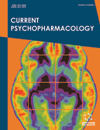- Home
- A-Z Publications
- Current Psychopharmacology
- Previous Issues
- Volume 9, Issue 3, 2020
Current Psychopharmacology - Volume 9, Issue 3, 2020
Volume 9, Issue 3, 2020
-
-
Transmodulation of Dopaminergic Signaling to Mitigate Hypodopminergia and Pharmaceutical Opioid-induced Hyperalgesia
More LessNeuroscientists and psychiatrists working in the areas of “pain and addiction” are asked in this perspective article to reconsider the current use of dopaminergic blockade (like chronic opioid agonist therapy), and instead to consider induction of dopamine homeostasis by putative pro-dopamine regulation. Pro-dopamine regulation could help pharmaceutical opioid analgesic agents to mitigate hypodopaminergia-induced hyperalg Read More
-
-
-
Overview on Phyto-based Treatment for Anxiety
More LessAuthors: Jyoti Alambayan and Vandana GargBackground: The prevalence of psychiatric disorders, such as anxiety, is very common and affects many people all around the world. Currently, many synthetic pharmacological products/ drugs are available in the market to cure the disorder but associated with various adverse reactions or side effects, which may cause discomfort and sometimes other disorders to the patients. In the past years, the use of complementary a Read More
-
-
-
Improvement of Negative Symptoms in Schizophrenia: A Double-blind Clinical Trial by Escitalopram in Male Patients
More LessBackground: The negative symptoms of schizophrenia remain a major clinical trouble against psychiatric rehabilitation and available therapeutic treatments. Objective: Escitalopram is known as the most selective SSRI with minimal effects on norepinephrine and dopamine neuronal uptake. The aim of the present study is to assess the effect of escitalopram on negative symptoms of schizophrenia. Methods: This study was an Read More
-
-
-
A Study of Metabolic Syndrome in Patients on Risperidone
More LessAuthors: Ajay Thangraj, Nimesh G. Desai and Vijender SinghBackground: Novel antipsychotics are superior to conventional antipsychotics, as they significantly reduce both positive and negative symptoms of schizophrenia and have lower risk of extra pyramidal syndrome (EPS). However, these drugs cause significant metabolic side effects. Objective: This study was carried out to assess the hospital prevalence of metabolic syndrome (MetS) and metabolic profile related to use of oral ri Read More
-
-
-
Medication-precipitated Seizure in Psychiatric Patients: Typical vs. Atypical Antipsychotics
More LessBackgrounds: It is unknown whether second-generation antipsychotics are safer than first-generation antipsychotics in terms of seizure induction. Objective: In the present assessment, the relationships between the incidence of seizure attacks among a great sample of non-western psychiatric inpatients and prescribed typical and atypical antipsychotics have been probed and analyzed based on the existing data in the literature. Read More
-
-
-
Method Validation for the Determination of Carbamazepine in Spiked-saliva Using HPLC-UV for Therapeutic Drug Monitoring Application
More LessAuthors: Ari Wibowo, Vitarani D.A. Ningrum and Rahma N. IlhamyBackground: Carbamazepine has been used in the treatment of bipolar disorder, both in acute mania and maintenance therapy, particularly in developing countries. Not only its interaction with various drugs and auto-inducer nature, but the narrow therapeutic range of carbamazepine also makes monitoring necessary to guarantee the adequacy of its safety and therapeutic concentration. To date, the most common biologic Read More
-
Most Read This Month
Article
content/journals/cpsp
Journal
10
5
false
en


